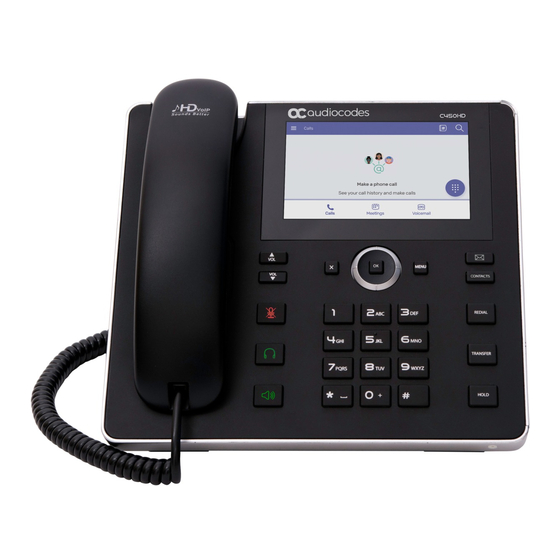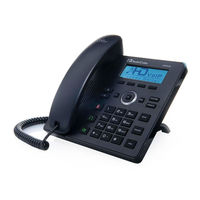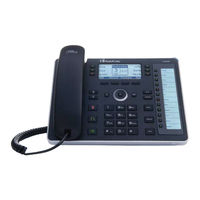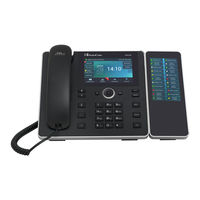
AudioCodes C450HD Manuals
Manuals and User Guides for AudioCodes C450HD. We have 17 AudioCodes C450HD manuals available for free PDF download: Administrator's Manual, User Manual, User's And Administrator's Manual, User And Administrator Manual, Release Notes, Quick Manual
AudioCodes C450HD Administrator's Manual (242 pages)
High Definition IP Phones Series
Brand: AudioCodes
|
Category: IP Phone
|
Size: 4 MB
Table of Contents
Advertisement
AudioCodes C450HD Administrator's Manual (235 pages)
Brand: AudioCodes
|
Category: IP Phone
|
Size: 7 MB
Table of Contents
AudioCodes C450HD User Manual (170 pages)
IP Phone for Microsoft Skype for Business
Brand: AudioCodes
|
Category: IP Phone
|
Size: 7 MB
Table of Contents
Advertisement
AudioCodes C450HD User's And Administrator's Manual (130 pages)
Brand: AudioCodes
|
Category: IP Phone
|
Size: 15 MB
Table of Contents
AudioCodes C450HD User's And Administrator's Manual (121 pages)
Brand: AudioCodes
|
Category: IP Phone
|
Size: 13 MB
Table of Contents
AudioCodes C450HD User's And Administrator's Manual (117 pages)
Brand: AudioCodes
|
Category: IP Phone
|
Size: 12 MB
Table of Contents
AudioCodes C450HD Administrator's Manual (190 pages)
High-Definition IP Phones
Brand: AudioCodes
|
Category: IP Phone
|
Size: 3 MB
AudioCodes C450HD User's And Administrator's Manual (82 pages)
Brand: AudioCodes
|
Category: IP Phone
|
Size: 7 MB
Table of Contents
AudioCodes C450HD User And Administrator Manual (60 pages)
High Definition IP Phones Series for Microsoft Teams
Brand: AudioCodes
|
Category: IP Phone
|
Size: 3 MB
Table of Contents
AudioCodes C450HD User's And Administrator's Manual (62 pages)
IP Phone for Microsoft Teams Application
Brand: AudioCodes
|
Category: IP Phone
|
Size: 3 MB
Table of Contents
AudioCodes C450HD Release Notes (48 pages)
IP Phones for Microsoft Teams
Brand: AudioCodes
|
Category: IP Phone
|
Size: 2 MB
Table of Contents
AudioCodes C450HD User Manual (111 pages)
Generic SIP
Brand: AudioCodes
|
Category: IP Phone
|
Size: 4 MB
AudioCodes C450HD Quick Manual (12 pages)
IP Phone for Microsoft Teams
Brand: AudioCodes
|
Category: IP Phone
|
Size: 1 MB
Table of Contents
AudioCodes C450HD Quick Manual (11 pages)
IP Phone with Microsoft Skype for Business
Brand: AudioCodes
|
Category: IP Phone
|
Size: 1 MB
Table of Contents
AudioCodes C450HD Quick Manual (12 pages)
Brand: AudioCodes
|
Category: IP Phone
|
Size: 1 MB
Table of Contents
AudioCodes C450HD Quick Manual (10 pages)
IP Phone for Microsoft Teams
Brand: AudioCodes
|
Category: IP Phone
|
Size: 1 MB
Table of Contents
AudioCodes C450HD Quick Manual (5 pages)
Brand: AudioCodes
|
Category: IP Phone
|
Size: 0 MB
















